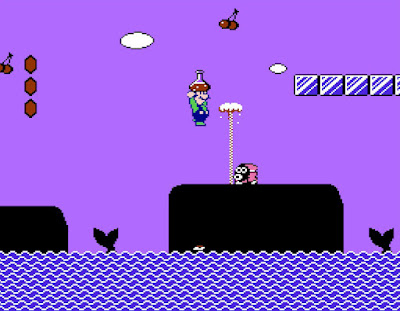On its surface, Snakebird is simple—deceptively simple. Your gluttonous snakebirds have only two objectives: eat all of the fruit on a level, and then escape through the rainbow portal. For each piece of fruit a snakebird consumes it will grow by one block, allowing it to reach new areas and bridge wide chasms. While this doesn't sound too bad, remember that gravity is an omnipresent menace, requiring your snakebirds to be anchored by at least one square or face plummeting to their doom. Like I said, it's an uncomplicated premise, but the way Noumenon Games designs their stages will wring every ounce of brainpower out of your feeble little mind.
Don't believe me? Out of its 50+ levels, it's Level 2 that's your first impasse—one of the game's introductory puzzles! And the experience doesn't get easier from there, oh no; expect to be stymied frequently, even multiple times within the same stage. You'll contort your snakebirds into painful configurations in order to reach sequestered fruits... and then realize you've gotten them permanently stuck (Level 11, 42). Or you'll spend half an hour reverse engineering how to reach every piece of fruit... but fail to plan an escape route back to the rainbow portal (Level 21, 45). Should you even chance upon the rare "easy" puzzle, expect Snakebird to throw a curveball soon after, leaving you more stumped than the remains of a lumberjack's rampage (Level... well, every level).
What truly catapults Snakebird into the lunatic stratosphere are three brain-bending mechanics that get slowly introduced. The first is the ability to control multiple snakebirds, dynamically changing how you move about the world (Level 19, 26) while also tacking on more ways you to get yourself stuck (Level 17, 20). The second is some good old fashion box pushing, which will rankle you beyond belief as you struggle to transport the stubborn squares from point A to point B (Level 23, 39, *1). And third is playing with position-swapping portals, which require as much terrifying foresight as you can imagine the mechanic implies (Level 38, 44).
While the odds may be stacked against you, at least you always have the "Undo" button in your back pocket, allowing you to backtrack all the way to your very first, naïve move. Without it the game would be hilariously unplayable, given how often your snakebirds worm their way off of cliffs or jam themselves into a corner. The only downside is that you have to mash the backwards key in order to return to "safe" point on the longer levels, forcing you to relive all of the turns you wasted putzing about. The "Undo" button is still a much appreciated, integral mechanic—I just wish it was a rewind function with a preview instead.
If it sounds like I reviled my torturous time with Snakebird, the opposite is actually true—I greatly adore and respect the game! It may have been unexpectedly brutal but it's never cruel for the sake of it; Snakebird treats you as an adult, letting you know early on that it's going to take your time with it seriously. To use a sour but effective phrase, Snakebird is the Dark Souls of puzzlers: you either adapt to its stubborn rules or scamper away with your tail between your legs. The stages themselves are truly impressive, often containing a singular solution with very little wasted space or structural red herrings. It's an utterly phenomenal video game from a design standpoint alone—and probably the best 2D puzzler I played since The Swapper—but heed the warning I've been echoing this entire entry: Snakebird is not welcoming, soft, nor remotely pitying. Some of the latter stages are so difficult (curse that final level!) that you may find it easier (and quicker!) to chew through an ingot of pure iron.
Snakebird is a brilliant puzzler but I was nevertheless relieved to finally be done with it. This goddamn game has haunted me for far too long—I've been trying to beat it since 2016! Well, not actively—more like once a year until I get overwhelmed—but its presence has weighed heavy on my prideful mind, holding me back from exploring games like Baba is You, Recursion, and Magnibox. "How are you going to bridge this gap?" It would jeer when I ran out of all feasible options, "Which snakebird should eat the fruit? How do you wriggle out of this spot? How are you going to move this box across the entire level?" Snakebird is deceptive and malicious, but like any good villain it's also exceedingly smart—so smart that I can think of few games as downright sinister as it. So congratulations Noumenon Games; I can only hope you're using those dastardly brains of yours nowadays for good and not ill—because lord help us if you aren't.












